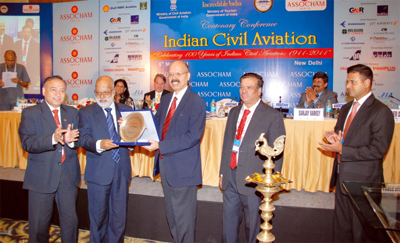|
The exponential growth of the Indian civil aviation
sector needs investments worth over US $30 billion
in the next 15 years and the Civil Aviation Ministry
has worked out a road-map to facilitate this,
according to Secretary Civil Aviation Dr Nasim
Zaidi.
Inaugurating the Centenary conference of Indian
Civil Aviation, organized by ASSOCHAM (the Associated
Chambers of Commerce and Industry), he outlined
three keyinitiatives that the Ministry was taking
during the year – creation of a National registry
of Airports; Formation of a Civil Aviation Authority;
and an independent Investigation Board.
Twelve greenfield airports are currently being
developed as the country’s unique geographical
position offers an opportunity to become a global
hub for airlines, he informed. On a positive note
with a total of 142 million passengers checked
in and out of airports across the country during
2010-11, marking a growth of 15 per cent over
the previous year, civil aviation seems to be
a galloping industry in India after a hundred
years.
Out of the 130 airports, 124 are owned and operated
by the staterun Airports Authority of India (AAI),
which includes 12 International Airports, 81 Domestic
Airports, 8 Customs Declared Airports and 23 Civil
Enclaves. The passenger growth has been phenomenal
at 23 per cent in 2010-11, up from 19 per cent
the previous period. Only two per cent and 0.5
per cent Indians fly domestic and international
respectively. Though, Indians are way behind,
there is a huge potential. but the growth of the
sector is critically dependent on infrastructure,
safety, liberalization, human resources and environment,
Dr Zaidi said.
 The
Director General of Association of Asia Pacific
Airlines (AAPA), Andrew Herdman, said while the
Asia-Pacific region was doing well commercially
in the aviation sector, on the regulatory front
the dominance of the US and Europe continued.
Aviation as a business faces significant regulatory
constraints and there was a need to revisit the
issues for global standardization. The outlook
for the sector was quite dampening as crude oil
prices were touching $120 a barrel. Oil price
volatility impacts the aviation sector, more so
in India due to the high taxation regime. The
Director General of Association of Asia Pacific
Airlines (AAPA), Andrew Herdman, said while the
Asia-Pacific region was doing well commercially
in the aviation sector, on the regulatory front
the dominance of the US and Europe continued.
Aviation as a business faces significant regulatory
constraints and there was a need to revisit the
issues for global standardization. The outlook
for the sector was quite dampening as crude oil
prices were touching $120 a barrel. Oil price
volatility impacts the aviation sector, more so
in India due to the high taxation regime.
He pegged the Asia Pacific aviation industry’s
annual volume at 158 billion dollars with 4,712
aircraft, 684 million passengers and 18 million
tonnes of cargo. The region contributed to half
of 16 billion dollar profit earned by all airlines
around the world.
The conference deliberated on three issues –
‘Airports: constraints and growth drivers’; ‘Airlines
industry: challenges and opportunities’; and ‘Training
and capacity building’ with a host of experts
giving their perspectives. India being a highly
under-serviced market, they were optimistic about
the opportunities, but the challenges were many
– infrastructural issues; high taxation; undue
regulation; human resource requirements etc.
M K Narayana Rao, Chairman of ASSOCHAM’s civil
aviation committee, said Indian aviation has seen
a tremendous growth in the past 10 years due to
government’s open skies policy, arrival of low-cost
airlines and air travel becoming more affordable
for middle-income people. According to conservative
estimates, passenger traffic is likely to be around
540 million by 2025 as the fleet size of scheduled
airlines increases to 1,500 from 430 now. At the
same time, cargo traffic is expected to touch
nine million tonnes from 2.33 million tonnes in
the last financial year.
Amber Dubey, Director at KPMG (India), said the
industry and the government must tackle policy
and regulatory challenges.
He said airport charges must come down and ground
handling operations need to be streamlined so
that passengers can experience world-class services.
State aviation secretaries will soon meet to provide
inputs for toning up the infrastructure. The industry
also needs to set up training institutes in various
areas, especially to train air traffic controllers.
D S Rawat, Secretary General ASSOCHAM , said
the Indian civil aviation industry is at an inflexion
point and set to enter the next phase of growth
with even greater momentum.
Jet Airways was given the award for being the
best Indian global carrier, ‘Deccan 360’ the best
cargo airline, Delhi International Airport Limited,
the best managed airport and Franklinn, the best
training institute.
|